登録情報 データベース : PDB / ID : 4n90タイトル Crystal structure of ternary complex of TRAIL, DR5, and Fab fragment from a DR5 agonist antibody Fab heavy chain Fab light chain Tumor necrosis factor ligand superfamily member 10 Tumor necrosis factor receptor superfamily member 10B キーワード / / / / / / / 機能・相同性 分子機能 ドメイン・相同性 構成要素
/ / / / / / / / / / / / / / / / / / / / / / / / / / / / / / / / / / / / / / / / / / / / / / / / / / / / / / / / / / / / / / / / / / / / / / / / / / / / / / / / / / / / / / 生物種 Homo sapiens (ヒト)手法 / / / 解像度 : 3.3 Å データ登録者 Huang, X. ジャーナル : Cancer Cell / 年 : 2014タイトル : Apo2L/TRAIL and the Death Receptor 5 Agonist Antibody AMG 655 Cooperate to Promote Receptor Clustering and Antitumor Activity.著者: Graves, J.D. / Kordich, J.J. / Huang, T.H. / Piasecki, J. / Bush, T.L. / Sullivan, T. / Foltz, I.N. / Chang, W. / Douangpanya, H. / Dang, T. / O'Neill, J.W. / Mallari, R. / Zhao, X. / ... 著者 : Graves, J.D. / Kordich, J.J. / Huang, T.H. / Piasecki, J. / Bush, T.L. / Sullivan, T. / Foltz, I.N. / Chang, W. / Douangpanya, H. / Dang, T. / O'Neill, J.W. / Mallari, R. / Zhao, X. / Branstetter, D.G. / Rossi, J.M. / Long, A.M. / Huang, X. / Holland, P.M. 履歴 登録 2013年10月18日 登録サイト / 処理サイト 改定 1.0 2014年9月3日 Provider / タイプ 改定 1.1 2024年11月6日 Group Data collection / Database references ... Data collection / Database references / Derived calculations / Structure summary カテゴリ chem_comp_atom / chem_comp_bond ... chem_comp_atom / chem_comp_bond / database_2 / pdbx_entry_details / pdbx_modification_feature / struct_conn / struct_site Item _database_2.pdbx_DOI / _database_2.pdbx_database_accession ... _database_2.pdbx_DOI / _database_2.pdbx_database_accession / _struct_conn.ptnr1_auth_asym_id / _struct_conn.ptnr1_auth_comp_id / _struct_conn.ptnr1_auth_seq_id / _struct_conn.ptnr1_label_asym_id / _struct_conn.ptnr1_label_atom_id / _struct_conn.ptnr1_label_comp_id / _struct_conn.ptnr1_label_seq_id / _struct_conn.ptnr2_auth_asym_id / _struct_conn.ptnr2_auth_comp_id / _struct_conn.ptnr2_auth_seq_id / _struct_conn.ptnr2_label_asym_id / _struct_conn.ptnr2_label_atom_id / _struct_conn.ptnr2_label_comp_id / _struct_conn.ptnr2_label_seq_id / _struct_site.pdbx_auth_asym_id / _struct_site.pdbx_auth_comp_id / _struct_site.pdbx_auth_seq_id
すべて表示 表示を減らす
 データを開く
データを開く 基本情報
基本情報 要素
要素 キーワード
キーワード 機能・相同性情報
機能・相同性情報 Homo sapiens (ヒト)
Homo sapiens (ヒト) X線回折 /
X線回折 /  シンクロトロン /
シンクロトロン /  分子置換 / 解像度: 3.3 Å
分子置換 / 解像度: 3.3 Å  データ登録者
データ登録者 引用
引用 ジャーナル: Cancer Cell / 年: 2014
ジャーナル: Cancer Cell / 年: 2014 構造の表示
構造の表示 Molmil
Molmil Jmol/JSmol
Jmol/JSmol ダウンロードとリンク
ダウンロードとリンク ダウンロード
ダウンロード 4n90.cif.gz
4n90.cif.gz PDBx/mmCIF形式
PDBx/mmCIF形式 pdb4n90.ent.gz
pdb4n90.ent.gz PDB形式
PDB形式 4n90.json.gz
4n90.json.gz PDBx/mmJSON形式
PDBx/mmJSON形式 その他のダウンロード
その他のダウンロード 4n90_validation.pdf.gz
4n90_validation.pdf.gz wwPDB検証レポート
wwPDB検証レポート 4n90_full_validation.pdf.gz
4n90_full_validation.pdf.gz 4n90_validation.xml.gz
4n90_validation.xml.gz 4n90_validation.cif.gz
4n90_validation.cif.gz https://data.pdbj.org/pub/pdb/validation_reports/n9/4n90
https://data.pdbj.org/pub/pdb/validation_reports/n9/4n90 ftp://data.pdbj.org/pub/pdb/validation_reports/n9/4n90
ftp://data.pdbj.org/pub/pdb/validation_reports/n9/4n90 リンク
リンク 集合体
集合体



 要素
要素 Homo sapiens (ヒト)
Homo sapiens (ヒト)
 Homo sapiens (ヒト) / 遺伝子: TNFSF10, APO2L, TRAIL / 発現宿主:
Homo sapiens (ヒト) / 遺伝子: TNFSF10, APO2L, TRAIL / 発現宿主: 
 Homo sapiens (ヒト)
Homo sapiens (ヒト) Homo sapiens (ヒト)
Homo sapiens (ヒト) X線回折 / 使用した結晶の数: 1
X線回折 / 使用した結晶の数: 1  試料調製
試料調製 シンクロトロン / サイト:
シンクロトロン / サイト:  APS
APS  / ビームライン: 21-ID-F / 波長: 0.9787 Å
/ ビームライン: 21-ID-F / 波長: 0.9787 Å 解析
解析 分子置換 / 解像度: 3.3→50 Å / σ(F): 0 / 立体化学のターゲット値: Engh & Huber
分子置換 / 解像度: 3.3→50 Å / σ(F): 0 / 立体化学のターゲット値: Engh & Huber ムービー
ムービー コントローラー
コントローラー



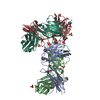
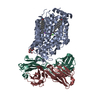
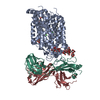
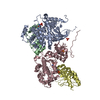


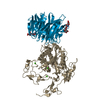

 PDBj
PDBj














